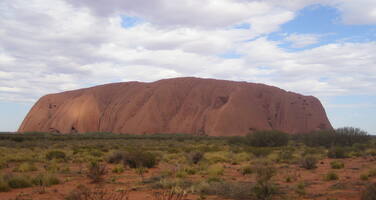Uluru-Kata Tjuta National Park
Factors affecting the property in 1997*
- Other Threats:
No specific threat identified
International Assistance: requests for the property until 1997
Total amount approved : 0 USD
Missions to the property until 1997**
Conservation issues presented to the World Heritage Committee in 1997
At its twenty-first ordinary session in June 1997, the Bureau, based on written and oral presentations made by IUCN, noted several positive developments with regard to the state of conservation of the following World Heritage sites: Tasmanian Wilderness, Uluru-Kata Tjuta National Park and the Great Barrier Reef.
The Australian authorities have been requested to provide, before 15 October 1997, a copy of the Regional Forest Agreement and a report on the relevance of that Agreement for the maintenance of the integrity of the Tasmanian Wilderness.
Since the conclusion of the twenty-first session of the Bureau in June 1997 however, the following communications, addressed to the Chairperson of the World Heritage Committee, were received by the Centre:
- from the Australian Conservation Foundation (ACF) highlighting the actual and potential threats to the integrity of the Kakadu National Park, arising from the proposal to mine the Jabiluka uranium deposit located within the outer boundaries of the Park; and
- from the Friends of Hinchinbrook Society in Queensland, Australia, highlighting threats to the Great Barrier Reef World Heritage Area due to developments in the Hinchinbrook area and requesting the Committee to consider including the Great Barrier Reef in the List of World Heritage in Danger.
These communications were transmitted to the Chairperson, the Permanent Delegate of Australia to UNESCO and IUCN for their review and comments.
Analysis and Conclusion by World Heritage Centre and the Advisory Bodies in 1997
The Bureau may wish to examine information that may be available at the time of its session and take appropriate action thereupon.
Summary of the interventions
Decisions adopted by the Committee in 1997
21 BUR IV.B.17
Australian World Heritage Sites
Introducing its written report on the state of conservation of natural World Heritage properties, IUCN supplemented this with a verbal report on more recent developments in Australia. IUCN recalled previous discussions of the Bureau and the Committee on the future of forested public lands adjoining the Tasmanian Wilderness World Heritage Area and the response at that time by the State Party that World Heritage issues would be taken into account in the negotiation of a Regional Forest Agreement between the Governments of Australia and the State of Tasmania. The IUCN Representative said that a World Heritage Expert Panel had reported in June 1997 to the two Governments to facilitate consideration of World Heritage issues. This report and extensive data bases should ensure that information on World Heritage potential would be available when decisions are made in finalizing the Regional Forest Agreement due to be completed by 30 June 1997.
The Bureau decided to commend the State Party on the comprehensive approach adopted and to invite the State Party to report to the Centre on the outcome relevant to World Heritage by 15 October 1997.
IUCN also commented favourably on the manner in which World Heritage cultural and natural values are being taken into account in the preparation of a new management plan for the Uluru-Kata Tjuta National Park, including a workshop held on 16 June 1997 with the Anangu people (traditional and legal owners of the Park) and Park staff on the implications of World Heritage status on visitor management. Issues raised in the IUCN report on other sites, i.e. Great Barrier Reef, Kakadu National Park and Shark Bay, noted a number of positive decisions taken, particularly those aimed at conserving dugong habitats in the Great Barrier Reef.
The Delegate of Australia commented in detail on all the issues raised in the IUCN report about Australia and suggested that IUCN seek official comment from the Australian government as the next step. She also expressed concern at the lack of time to consider and respond to the report and requested more advanced consultations with the State Party to permit dialogue on the issues raised. Concern at the late tabling of the report was also expressed by the Delegate of Germany. The Delegate of Australia assured the Bureau that the State Party would continue to maintain its commitment to respect the integrity of its World Heritage sites.
The Chairperson ruled that the issues raised in the IUCN report should not be further considered at this meeting, because in many cases the States Parties had not been given the opportunity to examine the issues raised, to verify their accuracy and to respond.
Exports
* :
The threats indicated are listed in alphabetical order; their order does not constitute a classification according to the importance of their impact on the property.
Furthermore, they are presented irrespective of the type of threat faced by the property, i.e. with specific and proven imminent danger (“ascertained danger”) or with threats which could have deleterious effects on the property’s Outstanding Universal Value (“potential danger”).
** : All mission reports are not always available electronically.


